In Part 3 of our 4-part blog series on ‘Holistic’ Physiotherapy, we’ll look into the key concepts that our practitioners follow. We’ll explore the history of physiotherapy, its methodology and the research that backs it.
Part 3: Key Concepts
Before we get started with defining exactly what Physiotherapy Care is, its methodology, the scientific research backing its efficacy, and how it can help you, we should first look at several key concepts that are indicative of all (ES) ‘Pain and Dysfunction’ practitioners, regardless of their professional status – Chiropractor, Physiotherapist, Osteopath.
Key Point 1
All of our ES ‘Pain and Dysfunction’ practitioners consult at the ‘Pain and Dysfunction’ level of the Performance Pyramid.
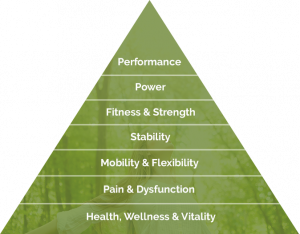

The figure above represents the organ/gland symptom referral patterns of the body. As you can see, when organs are unhealthy, inflamed, or not functioning properly on a physiological level, they can communicate this to us by creating specific symptoms. We may perceive this organ message as nerve-like pain, headaches, migraines, muscular tightness/pain or even joint pain. When this occurs, it would be inappropriate for our ‘Pain and Dysfunction’ practitioners to treat you. In this situation there are two options: The skilled (ES) holistic health practitioner could mentor you through a ‘Lifestyle Modification’ program, or refer you to a skilled dietician, doctor, or naturopath.
Once you have booked a consultation with a pain and dysfunction practitioner, you will receive a ‘Welcome Email’ that includes a section related to your current and previous health history. The main reason for obtaining this information from you is so that our practitioners can evaluate your overall health status and ensure that the cause of your problem is neuro-musculoskeletal in nature and that your body’s ability to heal is not being limited by poor health status.
Is your ‘pain generator’ from a source that our pain and dysfunction practitioners can influence? The last thing we want to do is chase symptoms around your body and avoid the true cause of the problem.
Possible Neuro-Musculoskeletal Pain Generators
- Central nervous system
- Spinal discs
- Tendons
- Joints
- Nerve roots
- Joint cartilage
- Muscles
- Scar tissue
- Peripheral nerves
- Ligaments
- Fascia
- Diaphragm
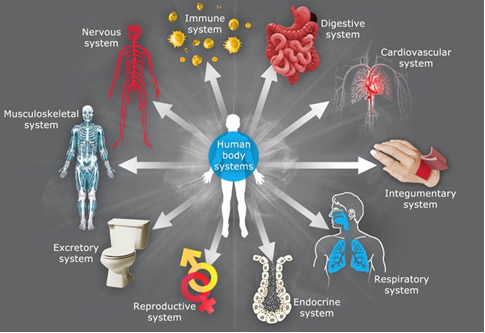
The 10 systems of the human body.
Through the nervous system and endocrine (hormonal) system, all of the systems of the body can communicate with each other. The old adage, ‘everything in the body is connected’ certainly holds true!
Key Point 2
All of our Effortless Superhuman (ES) ‘Pain and Dysfunction’ practitioners consult in accordance with (ES) Method.
Effortless Superhuman
The (ES) Method
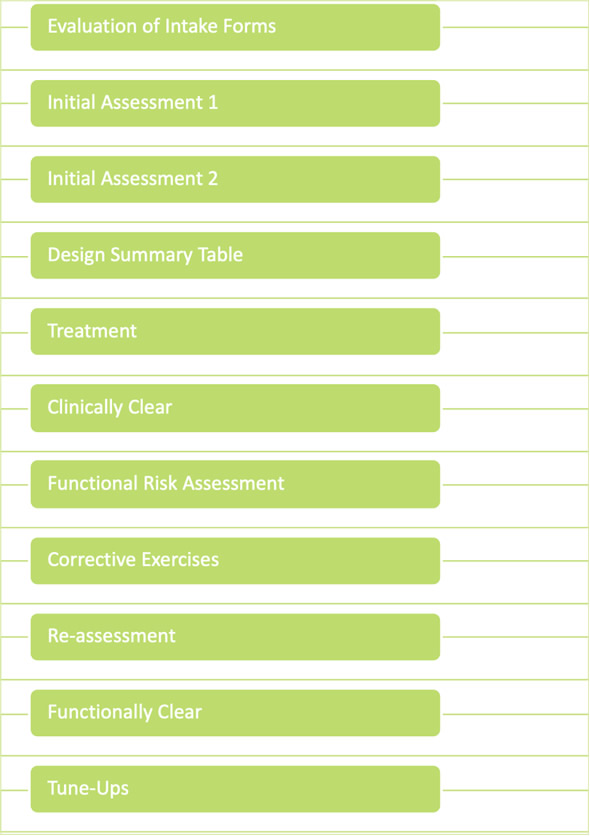
The (ES) Method
The first step in the process is for our practitioners to evaluate your ‘Intake Forms’ to gain a better understanding of why you would like to see us, what your ‘Good Outcome’ is, to evaluate your health status, and to have the opportunity to ask further questions if needed.
The next step is a comprehensive, full body assessment of your nerves, muscles, joints and other soft tissues. This information allows us to create a summary table highlighting your specific challenges and is used to establish the treatment plan.
Treatment by our practitioners will be aimed specifically at improving movement at specific joints within your body. We use the term ‘dysfunction’ to represent lack of movement at one or more joints within the body.
- Hip Flexion
- Neck Rotation
- Lower back bending
By increasing movement within your body, our practitioners can be confident that they are applying the right treatments and having a positive affect in your brain and on your body. Once all of your movement patterns have been restored and you’re pain-free you will be deemed as ‘clinically clear.’
Clinically Clear = Pain and Dysfunction Free
Decades of clinical experience have allowed us to determine that clinically clear and functionally clear are not the same thing. For example, a client may demonstrate normal ankle, knee, hip, back, neck and shoulder movement by the end of their treatment plan, and yet not be able to perform an overhead squat or lunge test. It’s for this reason that clinically clear is not enough. We must progress to the next stage of the (ES) Method – Functional Risk Assessment.
Clinically Clear ? Functionally Clear
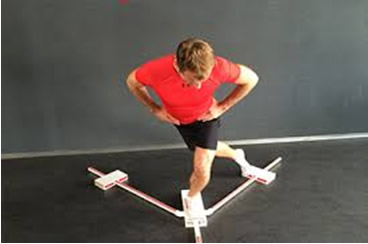 The functional risk assessment is a detailed movement analysis that leads to a risk profile being created. In other words, how likely are you to sustain an injury if you return to sport or activity? It’s through proper testing that our practitioners are able to pick up on movement faults that may be predispose you to injury or pain. This type of functional testing is objective (measureable) and can be used to reflect ‘true’ progress in a return to sport or activity program. With this information, our practitioners can provide precise corrective exercises that will improve your movement patterns and lower your injury risk.
The functional risk assessment is a detailed movement analysis that leads to a risk profile being created. In other words, how likely are you to sustain an injury if you return to sport or activity? It’s through proper testing that our practitioners are able to pick up on movement faults that may be predispose you to injury or pain. This type of functional testing is objective (measureable) and can be used to reflect ‘true’ progress in a return to sport or activity program. With this information, our practitioners can provide precise corrective exercises that will improve your movement patterns and lower your injury risk.
With the stresses and strains of the modern world, your body will require regular ‘tune-ups’ to keep it functioning at its best and symptom free. Your practitioner will therefore recommend that you have regular check-ups at defined intervals throughout the year. Clients with more demanding jobs, lifestyles or activities/sport will likely need to be seen more frequently.
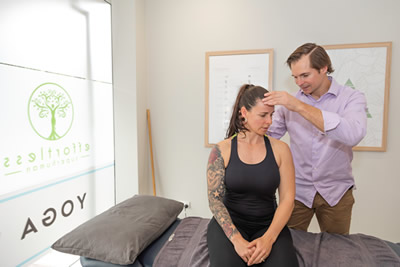
Physiotherapy Care
What is Physiotherapy Care?
Definitions
Physiotherapists are highly qualified health professionals who work in partnership with their patients to help people get better and stay well.
Physiotherapists also work closely with GPs and other health clinicians to plan and manage treatment. GPs refer more patients to physiotherapists than any other healthcare profession.
Using advanced techniques and evidence-based care, physiotherapists assess, diagnose, treat and prevent a wide range of health conditions and movement disorders. Physiotherapy helps repair damage, reduce stiffness and pain, increase mobility and improve quality of life.
Physiotherapy extends from health promotion to injury prevention, acute care, rehabilitation, maintenance of functional mobility, chronic disease management, patient and carer education and occupational health.
Australian Physiotherapy Association (APA)
Physiotherapists help people affected by injury, illness or disability through movement and exercise, manual therapy, education and advice.
They maintain health for people of all ages, helping patients to manage pain and prevent disease.
The profession helps to encourage development and facilitate recovery, enabling people to stay in work while helping them to remain independent for as long as possible.
Chartered Society of Physiotherapy
(Holistic) Physiotherapists are considered ‘pain and dysfunction’ practitioners and see themselves as passionate leaders, educators and mentors for all of their clients. They aim to inspire individuals to do the things that inspire them! These talented health professionals hold a holistic view of health and wellness: Mental, spiritual, social/emotional and physical and recognize their role as part of a multi-disciplinary (integrated) team of health professionals. Their growth mindset provides them with the ability to integrate the best skills, knowledge and methodology from a wide range of disciplines for the benefit of their clients: Osteopathy, physiotherapy, chiropractic, TCM, massage therapy, movement practitioners, naturopathy, holistic lifestyle coaches, functional medicine/nutrition, and more. Where possible, their approach to health and wellness and treatment is based firmly on scientific evidence and best practice principles.
Effortless Superhuman
History of Physiotherapy
Physiotherapy (PT), also known as physical therapy, is considered apart of the allied health professionals’ team and aims to provide a form of holistic healing and rehabilitation that remediates impairments and promotes health and happiness, mobility, function, and quality of life through a wide range of skills, knowledge and advanced methodologies.
In addition to clinical practice, other activities encompassed in the physiotherapy profession include research, education, consultation, and mentorship. Physiotherapists often work as part of a multi-disciplinary team and are seen as industry leaders.
Physicians such as Hippocrates and later Galen are believed to have been the first practitioners of physical therapy, advocating massage, manual therapy techniques, cold therapy, and hydrotherapy to treat people in 460 BC.
Per Henrik Ling, the “Father of Swedish Gymnastics”, founded the Royal Central Institute of Gymnastics (RCIG) in 1813 for manipulation and exercise. This is thought to have been the origin of actual physical therapy as a professional group.
Sjukgymnast = Physiotherapist
Someone involved in gymnastics for the benefit of those who are ill.
In 1887, physiotherapists were given official registration by Sweden’s National Board of Health and Welfare. Other countries soon followed.
- 1894, four nurses in Great Britain formed the Chartered Society of Physiotherapy.
- In 1906, a small group of massage therapists from Victoria, New South Wales, South Australia and Western Australia formed an association to provide stronger care to the general public.
- 1913, The school of Physiotherapy at the University of Otago in New Zealand
- 1914, Reed College in Portland, Oregon
Modern physical therapy was established towards the end of the 19th century due to events that had an effect on a global scale, which called for the rapid advances in physical therapy. Soon following, American surgeons began treating children with disabilities and began employing woman trained in physical education and remedial exercise. These treatments were applied and promoted further during the Polio outbreak of 1916.
During the First World War women were recruited to work with and restore physical function to injured soldiers, and the field of physical therapy was institutionalized. In 1918 the term “Reconstruction Aide” was used to refer to individuals practicing physical therapy. The first school of physical therapy was established at Walter Reed Army Hospital in Washington, D.C., following the outbreak of World War I.
In March 1921 the first physical therapy research was published in the United States in “The PT Review” and this event accelerated the growth of the profession.
Also in 1921, Mary McMillan organized the Physical Therapy Association, which is now called the American Physical Therapy Association (APTA).
In 1924, the Georgia Warm Springs Foundation promoted the field by touting physical therapy as a treatment for polio.
Treatment through the 1940s primarily consisted of massage, exercise and traction. Manipulative procedures of the spine and extremity joints began to be practiced in the early 1950s, especially in the British Commonwealth countries. It was around this time that physical therapists began to hold consistent positions within hospitals throughout North America and Europe.
In the late 1950s, physical therapists started to move beyond hospital-based practice to outpatient orthopedic clinics, public schools, colleges/universities healthcare centers, geriatric settings, rehabilitation centers and medical centers.
Specialization for physical therapy in the United States occurred in 1974, with the Orthopaedic Section of the APTA being formed for those physical therapists specializing in orthopaedics. In the same year, the International Federation of Orthopaedic Manipulative Physical Therapists was formed, which has since played an important role in advancing manual therapy worldwide.
References (A complete reference list can be provided upon request)
What type of education do Physiotherapists receive?
Physiotherapy courses vary across the country and entry may be through a bachelor, masters or professional doctorate program. Physiotherapists are required by law to be registered with the Physiotherapists Registration Board in the state or territory in which they are practising.
 Physiotherapists are required to adhere to strict and extensive ongoing educational requirements and are government regulated and accredited – Australian Health Professional Regulation Agency (AHPRA).
Physiotherapists are required to adhere to strict and extensive ongoing educational requirements and are government regulated and accredited – Australian Health Professional Regulation Agency (AHPRA).
What do Physiotherapists do?
(Holistic) Physiotherapy is a science-based profession and takes a ‘whole person’ approach to health and wellbeing, which includes the client’s general lifestyle.
At the core is the patient’s involvement in their own care, through education, awareness, empowerment and participation in their treatment.
Client’s can benefit from physiotherapy regardless of their age. Physiotherapy can assist in a wide range of areas including:
- Musculoskeletal Problems (Back pain, neck pain, whiplash, shoulder pain, knee injuries, post-operative rehabilitation)
- Rehabilitation following car accidents and work-related injuries
- Nerve related pain such as sciatica, nerve impingement, and carpal tunnel syndrome.
- Neurological conditions such as stroke, multiple sclerosis and Parkinson’s
- Sports injuries such as hamstring and calf tears, rotator cuff injuries, tennis elbow, golfer’s elbow, and tendonitis.
- Cardiovascular conditions such as chronic heart disease and rehabilitation after heart attack.
- Respiratory disorders such as asthma, chronic obstructive pulmonary disease, and cystic fibrosis.
- Recovery post childbirth (Pilates, Yoga, pelvic floor exercises)
There are special skills Physiotherapists bring to Effortless Superhuman and these have been incorporated into the (ES) practitioner training system and the (ES) Method.
- A holistic mindset towards health care including the understanding that lifestyle factors such as sleep, exercise, wholefood eating, stress levels, and happiness play a significant role in the healing process.
- Advanced dry needling skills
- Active Releasing techniques
- Neurodynamic Testing (NDT)
- Treatment Direction Testing (TDT)
- A range of mobilization techniques including Mobilization with movement (MWM), Manual release with movement (MRWM), NAGS, SNAGS
- Advanced taping qualifications
- Mobilization and manipulation of the spine and peripheral joints
- Ergonomic assessment and postural correction
- Neuro-based corrective exercise prescription (Mobility, flexibility, stability)
- Biomechanical analysis A keen understanding of all sports and activities and how to rehabilitate sports injuries
- Advanced skills in gym-based programming and progressions
- Advanced skills in soft tissue management including recovery from tendonitis, tendonopathy, fascial tightness and trigger points.
- Advanced knowledge in clinical reasoning theory and practice
- Strong skills in searching for, and evaluating research. Evidence-based practice and its application to the clinical setting.
In Part 4 of our 4-part blog series on ‘Holistic’ Physiotherapy, we’ll delve into the most frequently asked questions. Click here to jump right in!
To book an appointment with an ES practitioner please call (08) 9388 2768.
